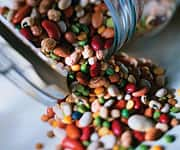Life Extension Magazine®
Q: I have read that fiber can help prevent cardiovascular disease. How much fiber do I need and what are the best sources? Are there any other benefits to increasing the amount of fiber in my diet? A: A century ago, before our food supply was industrialized and highly processed food became the norm, people ate an average of 28 grams of fiber a day. Conditions such as diabetes, heart disease, and obesity were far less common then than they are now. Even today, in cultures that eat a traditional, plant-based diet (sadly, there are fewer and fewer of them), diabetes, cancer, and cardiovascular disease are still rare. By contrast, the United States currently ranks lowest in fiber intake and highest in deaths from heart disease among 20 developed nations.1 The 2003 European Prospective Investigation into Cancer and Nutrition, which spanned 10 countries and included 519,978 participants who were observed for nearly five years, found that those with the highest amounts of fiber in their diets had a 40% lower risk of developing colon cancer that those with the lowest fiber intake.2 Other recent studies have found that increasing daily fiber intake by 10 grams lowers the risk of all coronary events by 14% and reduces the risk of death from heart disease by 27%.3 Fiber has been found to lower levels of triglycerides, low-density lipoprotein (LDL), C-reactive protein, and blood pressure—all of which are independent risk factors for heart attack and stroke.4-7
Fiber Fights Metabolic SyndromeAnother major risk factor for cardiovascular disease is body fat—particularly abdominal fat, which is strongly associated with elevated blood lipids, high blood pressure, and metabolic syndrome, a precursor to diabetes.8 High-fiber foods are digested much more slowly than are low-fiber foods, prolonging feelings of satiety or fullness by delaying the emptying of food from the stomach into the intestine, and allowing for the gradual absorption of nutrients from the small intestine into the bloodstream.9 This has significant implications for people with metabolic syndrome and diabetes.6 With the popularization of the glycemic index theory (which suggests minimizing the intake of foods that rapidly increase blood sugar), people with metabolic syndrome have been counseled to avoid starches and other carbohydrate-rich foods because it is believed that consuming them will lead to spikes in blood sugar and elevated insulin responses. This advice completely contradicts the latest scientific research.10 For example, a recent article in the Journal of Clinical Endocrinology & Metabolism compared popular glycemic index-based, low-carbohydrate diets to a high-fiber, high-carbohydrate diet emphasizing fresh fruits and vegetables. The study findings suggest that the fiber content of the foods eaten—rather than their glycemic index—was most beneficial for promoting insulin sensitivity.11 A classic Mediterranean diet, rich in carbohydrates and fiber from sources such as fruits, vegetables, whole grains, and nuts, has been shown over and over to be one of the best ways to improve metabolic syndrome.12 Because fiber slows the absorption of nutrients into the bloodstream, it naturally helps regulate blood sugar levels, preventing insulin surges and decreasing insulin resistance.13 It is abundantly clear that the best way to manage metabolic syndrome and decrease all of the cardiovascular risks that accompany it is by eating a diet high in complex carbohydrates supplying at least 25 grams of fiber a day. Fiber Promotes Weight LossTo help my patients lose weight and reduce their risk of heart disease, diabetes, and colon cancer, I developed a program called the Reality Diet, which promotes cardiovascular health and weight loss through a high-fiber diet and exercise. Why high fiber? My research and clinical experience indicate that fiber is the single best predictor of success when it comes to weight loss.
First and foremost, fiber promotes satiety—in other words, it makes you feel satisfied, or full.14 Satiety is one of the keys to successful weight loss, because no matter how much willpower you have, if your stomach is growling and you pass a Dunkin’ Donuts, you will be hard pressed to resist. If you are completely full, however, you will have an easier time passing it by. The federal government recommends that adults consume a minimum of 25 grams of fiber per day. On a good day, most Americans consume 12-17 grams. According to an article in the Journal of the American Medical Association, four popular fad diets—Atkins, Ornish, Weight Watchers, and Zone—provide an average of 15 grams per day.15 Yet study after study has shown that when people are allowed to eat as much as they want of a diet high in complex carbohydrates, they end up losing weight.16 Why? Because the fiber fills them up and they ultimately consume fewer calories per day. Fiber may also help promote weight loss by preventing the absorption of calories from the intestine. A US Department of Agriculture study showed that when a man doubled his fiber intake from 18 to 36 grams a day, he absorbed 130 fewer calories daily. Similarly, when a woman doubled her fiber intake from 12 to 24 grams a day, she absorbed 90 fewer calories daily.17 Over a year, that could add up to weight loss of 9 pounds for women and more than 13 pounds for men! Optimal Dietary Sources of FiberWhile many fad diets recommend consuming a high amount of fiber, they leave it up to the dieter to figure out how to get it. It is especially hard to get enough fiber on low-carb diets, since fruits, vegetables, and whole grains are the source of most fiber. Fats and meat contain no fiber at all. A few dairy and soy products contain fiber, but only in small amounts. In designing the Reality Diet, I made sure not only to “talk the talk” about fiber, but to “walk the walk,” providing a built-in mechanism to ensure adequate fiber intake.
In addition to eating a rich array of fruits and vegetables that are naturally high in fiber, I encourage my patients to eat several servings of whole-grain starches daily. Foods that are rich in fiber and made from whole grain are packed with vitamins, minerals, and antioxidants. These include not only high-fiber cereals and whole-wheat bread, but whole-grain pasta, bagels, waffles, crackers—just check the nutrition labels to make sure they contain a minimum of 2 grams of fiber per 90-calorie serving. Although meat and most dairy do not contain fiber, there are some fiber-fortified juices and yogurts hitting the market, and incorporating them in your diet will benefit your heart and waistline. While no single “magic bullet” will cure heart disease, a high-fiber diet combined with regular exercise comes closest. Not only will it reduce your cholesterol, blood pressure, and blood sugar, but it will give you energy and help you lose weight, reducing your risk of cardiovascular disease even further. Dr. Steven A. Schnur, a board-certified internist and cardiologist, is founder and president of South Florida Cardiology Associates, the largest cardiology practice in south Florida. He is the author of The Reality Diet (Avery Publishers, 2006). You can contact Dr. Schnur at stevenaschnur@aol.com. | ||||
| References | ||||
| 1. Shikany JM, White GL, Jr. Dietary guidelines for chronic disease prevention. South Med J. 2000 Dec;93(12):1138-51. 2. Bingham SA, Day NE, Luben R, et al. Dietary fibre in food and protection against colorectal cancer in the European Prospective Investigation into Cancer and Nutrition (EPIC): an observational study. Lancet. 2003 May 3;361(9368):1496-501. 3. Pereira MA, O’Reilly E, Augustsson K, et al. Dietary fiber and risk of coronary heart disease: a pooled analysis of cohort studies. Arch Intern Med. 2004 Feb 23;164(4):370-6. 4. Anderson JW, Smith BM, Gustafson NJ. Health benefits and practical aspects of high-fiber diets. Am J Clin Nutr. 1994 May;59(5 Suppl):1242S-7S. 5. Hu FB. Plant-based foods and prevention of cardiovascular disease: an overview. Am J Clin Nutr. 2003 Sep;78(3 Suppl):544S-51S. 6. Anderson JW. Whole grains protect against atherosclerotic cardiovascular disease. Proc Nutr Soc. 2003 Feb;62(1):135-42. 7. King DE. Dietary fiber, inflammation, and cardiovascular disease. Mol Nutr Food Res. 2005 Jun;49(6):594-600. 8. Hafidh S, Senkottaiyan N, Villarreal D, Alpert MA. Management of the metabolic syndrome. Am J Med Sci. 2005 Dec;330(6):343-51. 9. Kimm SY. The role of dietary fiber in the development and treatment of childhood obesity. Pediatrics. 1995 Nov;96(5 Pt 2):1010-4. 10. Brennan CS. Dietary fibre, glycaemic response, and diabetes. Mol Nutr Food Res. 2005 Jun;49(6):560-70. 11. Lara-Castro C and Garvey WT. Diet, insulin resistance, and obesity: zoning in on data for Atkins dieters living in South Beach. J Clin Endocrinol Metab. 2004 Sep;89(9):4197-205. 12. Serra-Majem L, Roman B, Estruch R. Scientific evidence of interventions using the Mediterranean diet: a systematic review. Nutr Rev. 2006 Feb;64(2 Pt 2):S27-S47. 13. Chandalia M, Garg A, Lutjohann D, et al. Beneficial effects of high dietary fiber intake in patients with type 2 diabetes mellitus. N Engl J Med. 2000 May 11;342(19):1392-8. 14. Delzenne NM, Cani PD. A place for dietary fibre in the management of the metabolic syndrome. Curr Opin Clin Nutr Metab Care. 2005 Nov;8(6):636-40. 15. Dansinger ML, Gleason JA, Griffith JL, Selker HP, Schaefer EJ. Comparison of the Atkins, Ornish, Weight Watchers, and Zone diets for weight loss and heart disease risk reduction: a randomized trial. JAMA. 2005 Jan 5;293(1):43-53. 16. Rolls BJ, Bell EA. Dietary approaches to the treatment of obesity. Med Clin North Am. 2000 Mar;84(2):401-18, vi. 17. Baer DJ, Rumpler WV, Miles CW, Fahey GC, Jr. Dietary fiber decreases the metabolizable energy content and nutrient digestibility of mixed diets fed to humans. J Nutr. 1997 Apr;127(4):579-86. |




